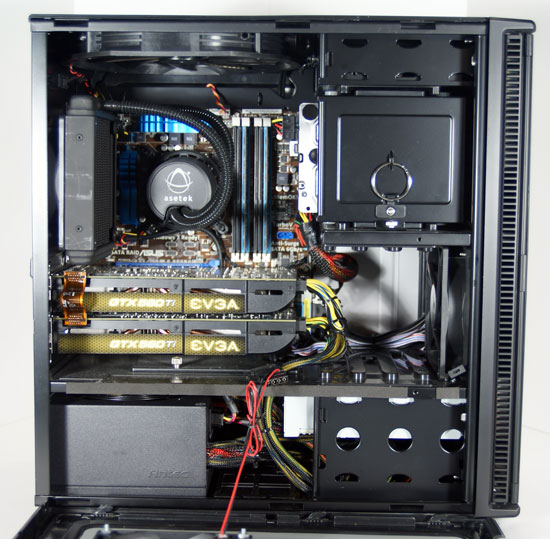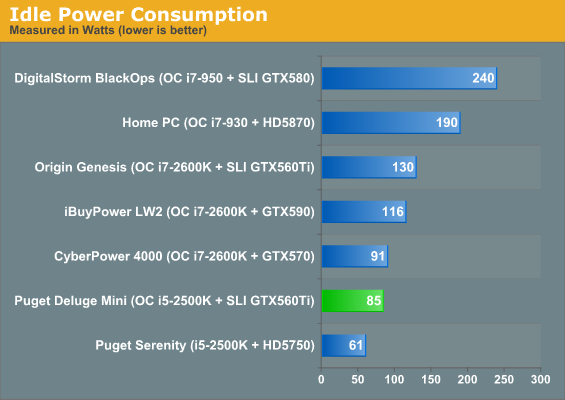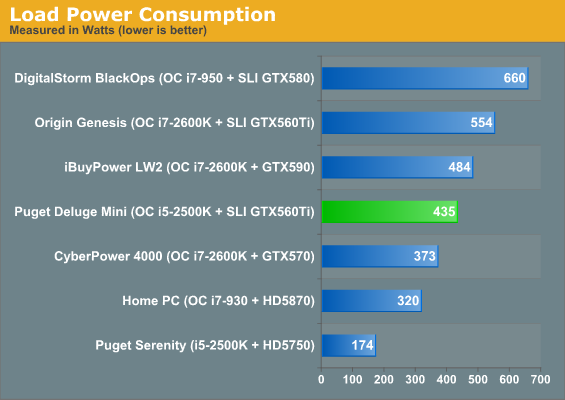Puget Systems Deluge Mini: The Art of Custom
by Dustin Sklavos on April 5, 2011 4:15 PM EST- Posted in
- Systems
- Intel
- Sandy Bridge
- GTX560
- Puget Systems
- NVIDIA
Build, Noise, Heat, and Power Consumption
It's really amazing what a single 120mm fan can do. Build quality is really where the Puget Systems Deluge Mini soars above the competing gaming towers we've tested, just like the Serenity SPCR Edition before it. I've had the opportunity to talk to the CEO of Puget Systems, Jon Bach, about their build process and how they go about designing the machines they sell and this is a good place to get into it.
Before even powerinng on the Deluge Mini there are two things that should immediately come to the astute reader's attention: Puget opts to use the highly-regarded Antec Mini P180 enclosure for this gaming build, and the P180 doesn't typically have a side intake fan. The Mini P180 enjoys all the sound dampening and thermal qualities of its larger siblings in the P180 series, but Puget Systems modifies the case by adding a 120mm intake fan directly above the video cards. The modification is extremely neat and tidy and would go essentially unnoticed to anyone who wasn't already familiar with this chassis. One of Puget's major claims in their build process is the use of thermal imaging to detect hot spots in their builds and weed them out. Adding the intake fan may seem like a "well duh" in retrospect, but it still takes extra time and effort to make the modification and it pays big dividends as you'll see.

Because Puget opts to use the Mini P180 along with a reasonably quiet watercooling solution for the processor, noise is virtually a non-issue with the Deluge Mini. While it's true the video cards do spin up under load testing, this is still overall one of the quietest gaming desktops we've ever tested and it's here that Puget Systems ekes out their major victory in comparison with the Origin Genesis: despite using a smaller chassis with more cramped internals, the Deluge Mini offers comparable gaming performance with both better thermals on the CPU and much better acoustics. That may have something to do with Puget's decision to employ an i5-2500K instead of the i7-2600K, too; on Nehalem-generation processors, losing Hyper-Threading shaves a few degrees off the load temperature of the processor.

The GeForce GTX 560 Ti tandem runs a little toastier in the Deluge Mini, but it's far less audible, and the processor runs substantially cooler despite using comparable voltage to the Origin Genesis and a theoretically less robust cooling system. A visit to UEFI shows what's also the most thoroughly fine-tuned overclocking job we've seen on any boutique system. Offset and turbo voltages have both been carefully adjusted.
This shouldn't completely take away from the Origin Genesis; the i7-2600K in their review unit was fairly power hungry and their engineers did a solid job of tuning the overclock. Puget's build just seems to handle heat better overall.


That fine-tuning really bears itself out in power consumption testing, where idle power is second only to Puget's own Serenity and load power remains very reasonable. Users concerned that the 650-watt Antec TruePower power supply might not be quite enough for this build should be satisfied to see it's got room to spare.
















25 Comments
View All Comments
SilthDraeth - Wednesday, April 6, 2011 - link
I was going to make a post but it is apparently spam.doobydoo - Wednesday, April 6, 2011 - link
Only when you do it :-)EBH - Wednesday, April 6, 2011 - link
Another 1000$ system that only uses:Audio
Realtek ALC892 HD Audio
Speaker, mic, line-in, and surround jacks for 7.1 sound
Optical out
/facepalm
strikeback03 - Wednesday, April 6, 2011 - link
I'm sure they offer external sound cards for the 0.0001% of the population who might notice a differenceRev1 - Thursday, April 7, 2011 - link
Is there much of a difference between a X58 sli and a P67? Meaning x16 x16 vrs. x16 x8 in terms of performance?